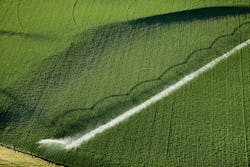While nutrients are a requirement for the vitality of plants and animals, when they enter the environment in large quantities they can have a negative impact on the system. Nutrient contamination refers to this excess input of nutrients, resulting in contamination. This contamination often ends up in the water system through accumulation in surface water and/or groundwater.
The most common nutrients seen in excess are nitrogen and phosphorus, which contaminate the environment through discharge from septic tanks, fossil fuel emissions, or most often, surface runoff from agricultural fields. These sources can be described either as point source or nonpoint source, those that can and can’t be attributed to one influence, respectively. In the case of point sources, the contamination travels directly from the source to the water, making it trackable and relatively easy to regulate. On the other hand, non-point source nutrients are more diffuse in nature as they come from a series of different sources which cannot be defined.
Agricultural run-off is a major source of excess nutrients in the environment .
Negative Implications
If contamination is not tracked and contained, it can have very negative effects on the environment, the economy and human health.
Within the environment, an excess supply of nutrients can cause excess growth of algae - resulting in algal blooms known as eutrophication. This eutrophication limits penetration of light and oxygen into the water, lowers water pH and increases carbon dioxide; setting off a chain reaction ultimately resulting in ecosystem collapse. From an economic perspective, nutrient excess requires significant costs to treat drinking water. Harmful algal blooms can close beaches, lakes and other recreational areas, whilst also negatively impacting the fishing industry as a result of the environmental damage. Finally, nutrient pollution can also directly impact human health through its consumption via drinking water. It’s known to have a variety of effects depending on the nutrient – these include stomach and liver issues, respiratory problems/conditions as well as neurological effects.
Based on these very significant impacts, it is crucial to trace where the nutrient pollution is coming from and track its movement through the environment. That way, treatment can be delivered at the pollution source.
Tracking Source with Isotopes
Boron (δ11B) Nitrogen (δ15N), and Oxygen (δ18O) can all be utilized to trace the source of nutrients based on the fact that many sources of nutrients have specific isotopic signatures, including industry chemicals (lubricants, additives), sewage, combustion of biomass and coal, manufacturing industry (e.g. steel), agricultural fertilizers, and household chemicals (bleaches, cleaners). These three isotopes (δ11B, δ15N, δ18O) are particularly useful as their elements are found in sources of nutrient contamination, including nitrates and phosphates.
When considering a single one of these isotopes, there are often overlapping ranges for a multitude of different nutrient sources, making it difficult to pinpoint the origin. In such cases, the application of multiple isotopes can be useful. For example, nitrate from fertilizers, soil and manure and sewage have characteristic nitrogen isotopic signatures, but differentiating between manure and sewage using δ15N alone is particularly difficult as the characteristic nitrogen isotopic signatures for these sources are indistinguishable. In the plot below, the nitrogen isotopes of manure and sewage samples range between approximately 2-11‰, mostly falling outside of the range for rain and fertilizers. As a result, while it is possible to distinguish between rainfall and fertilizer vs. manure and sewage, identifying the source between the latter two is still impossible with δ15N. In such cases, the analysis of a secondary isotope such as boron (δ11B) allows for the differentiation between the two sources - demonstrating the power of dual-isotope analysis.
In the example above, a series of four potential sources are known. However, this isn’t always the case. If the isotopic range for the nutrient contamination is not known for the site in question, it is possible to measure a series of potential sources as a means of developing a landscape-level baseline for nutrient source tracking.
For example, in a recent study by Briand et al. (2017) the source and fate of nitrates (NO3-) were analyzed from various sources across a catchment using combined boron (δ11B) and nitrogen (δ15N) isotopic measurements. Nitrates are a specific type of nitrogen pollution formed naturally via soil bacteria as well as through anthropogenic processes including food and fertilizer production as well as cattle waste. Given the multiple potential sources of nitrates and the potential to mix within a catchment, it can be difficult to interpret exact sources with high certainty.
In this study, the dual-isotopes were measured across various areas along two rivers in an agricultural area of France, where sources include livestock, fertilizers and wastewater, flowing through the soil and along the surface into the adjacent river system. Beyond the initial source, the various physical and chemical reactions that occur from source to river deposition are vital in determining the ultimate fate of contaminants within the system.
In this work, δ11B and δ15N were measured along several areas of the river system from July 2010 - March 2013 to capture spatial differences across numerous seasons. The authors were able to connect specific δ15N signatures to surface leaching and drainage during high-flow events. Furthermore, δ11B signatures were able to pinpoint sources of anthropogenic waters containing both animal and human waste; with the animal waste being more prevalent during high flow events. This study highlights the complexity in determining diffuse source nutrient pollution from a single catchment area - particularly when hydrological conditions are highly variable. It further demonstrates the importance of developing a site-specific baseline, measuring at various spatial and temporal scales.
In addition to boron and nitrogen, other isotopes - such as oxygen (δ18O) can play an important role in deciphering sources of both nitrates (NO3⁻) and phosphates (PO₄³⁻) as both contain oxygen. Phosphates are mined from phosphate rock and utilized in the agricultural industry as a growing stimulant based on the fact that phosphorus is a vital nutrient for plant growth and vitality. While valuable for food production, excess phosphate can result in nutrient pollution in heavy doses. The relative level and source of such phosphates can be identified using δ18O. For example, Elsbury et al. (2009) measured δ18O in phosphates in Lake Erie after finding that the lake δ18O levels were in disequilibrium with natural levels. While the authors couldn’t find a definitive source from δ18O alone, they were able to identify a connecting river as a likely place of origin. The analysis of δ18O in phosphates and nitrates can be more effective when combined with δ15N. For example, Harms et al. (2019) was able to identify sources of nutrients in the Indian Ocean subtropical gyre by measuring δ18O and δ15N in water mass nitrates - providing important information on nutrient distribution and relative supply.
Conclusions
Excess nutrients can have very negative effects on the environment, economy and human health - demonstrating the importance of tracking the source for remediation efforts. Whilst individual isotopes of nitrogen, boron and oxygen can provide an idea of the source, it is best pinpointed through the utilization of multiple isotopes measured on each sample. Where possible, an approach which integrates a suite of measurements across space and time will provide the most accurate and detailed results on the source and fate of contaminants through a landscape.
References
- Briand, C., Plagnes, V., Sebilo, M., Louvat, P., Chesnot, T., Schneider, M., Ribstein, P. and Marchet, P., (2013). Combination of nitrate (N, O) and boron isotopic ratios with microbiological indicators for the determination of nitrate sources in karstic groundwater. Environmental Chemistry, 10(5), pp.365-369. DOI: 10.1071/EN13036
- Briand, C., Sebilo, M., Louvat, P., Chesnot, T., Vaury, V., Schneider, M. and Plagnes, V., 2017. Legacy of contaminant N sources to the NO3− signature in rivers: a combined isotopic (δ15N-NO3−, δ18O-NO3−, δ11B) and microbiological investigation. Scientific Reports, 7(1), pp.1-11.
- Elsbury, K.E., Paytan, A., Ostrom, N.E., Kendall, C., Young, M.B., McLaughlin, K., Rollog, M.E. and Watson, S., 2009. Using oxygen isotopes of phosphate to trace phosphorus sources and cycling in Lake Erie. Environmental Science & Technology, 43(9), pp.3108-3114.
- Harms, N.C., Lahajnar, N., Gaye, B., Rixen, T., Dähnke, K., Ankele, M., Schwarz-Schampera, U. and Emeis, K.C., 2019. Nutrient distribution and nitrogen and oxygen isotopic composition of nitrate in water masses of the subtropical southern Indian Ocean. Biogeosciences, 16(13), pp.2715-2732.
- Li, H.B., Yu, S., Li, G.L. and Deng, H., 2011. Contamination and source differentiation of Pb in park soils along an urban–rural gradient in Shanghai. Environmental pollution, 159(12), pp.3536-3544






